The Acropolis of Athens is the most famous acropolis in the world and also one of the most important ancient monuments in the Western World. The Acropolis of Athens is considered to be the birthplace of Western Civilization. The Acropolis was first inhabited during the Neolithic Age, it was also inhabited during the Mycenaean period. Just like Mycenae and Tiryns, the Acropolis of Athens had its own underground water supply. There is little left from this period, only a few remains of a cyclopean wall. The Acropolis of Athens is home to several temples and sanctuaries and also to one of the most famous ancient building in the world, the Parthenon. The Parthenon dominates the Acropolis, the temple was built for the Greek goddess Athena Parthenos. Between 1802-1805, the English Lord Elgin removed half of the sculptures from the Parthenon and brought them to Great Britain. At that time, Greece was under Ottoman rule, Lord Elgin removed the sculptures, now known as the Elgin Marbles, with the permission of the Ottoman Empire.The Elgin Marbles are housed in the British Museum in London. Greece demands the return of the Elgin marbles, fruitless until today. The gate and main entrance to the Acropolis is formed by the Propylaea. The Temple of Nikè stands near the remains of a cyclopean wall from the Mycenaean era. The Erechtheum on the Acropolis of Athens is famous for its Caryatids columns. During the Ottoman Empire, the Erechtheum functioned as a harem. The Stoa of Eumenes is located at the foot of the Acropolis, between the Theatre of Dionysus and the Odeon of Herodes Atticus. The Theatre of Dionysus is the oldest theatre in the world. The Temple of the Olympian Zeus and the marble Arch of Hadrian are located at the foot of the Acropolis of Athens. The Acropolis of Athens gained the status as a UNESCO World Heritage in 1987. Photo Art: Return the Parthenon Elgin Marbles
www.werelderfgoedfotos.nl © Copyright World Heritage Photos
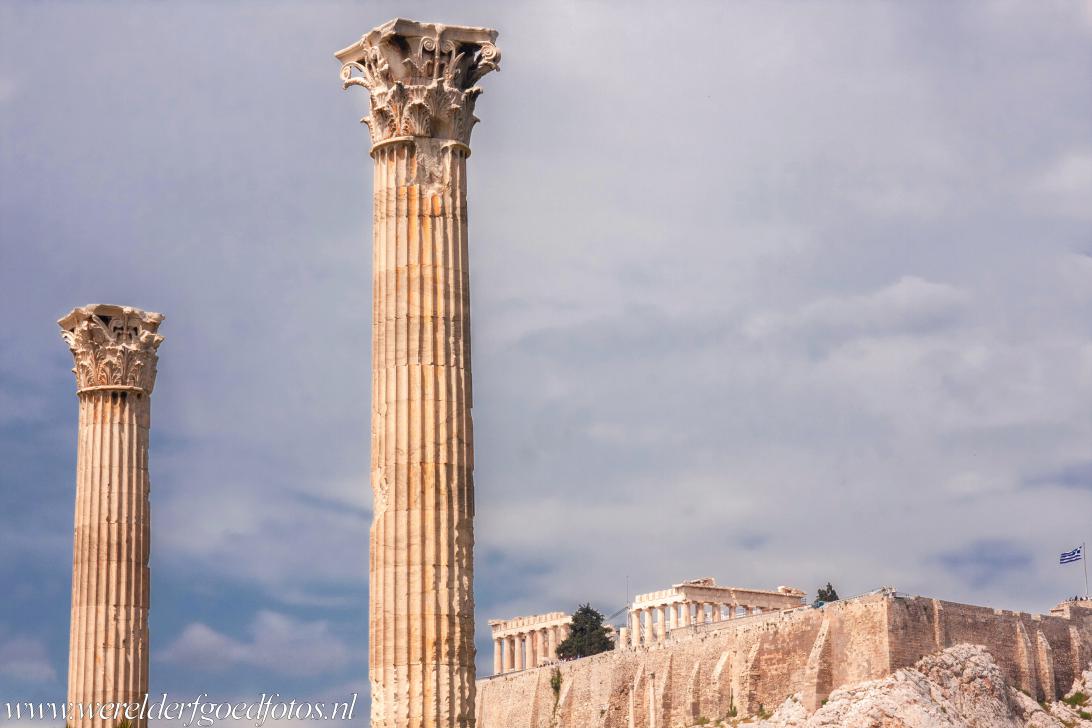
The Acropolis of Athens viewed from the Temple of the Olympian Zeus. The Acropolis of Athens is an ancient citadel and the most visited tourist attraction in all of Greece and one of the most famous tourist attractions in the world. The Acropolis is home to the Parthenon, the temple is one of the most famous ancient buildings in the world. The Acropolis of Athens was declared a UNESCO World Heritage in 1987.

The Acropolis of Athens viewed from the Temple of the Olympian Zeus. The Acropolis of Athens is an ancient citadel and the most visited tourist attraction in all of Greece and one of the most famous tourist attractions in the world. The Acropolis is home to the Parthenon, the temple is one of the most famous ancient buildings in the world. The Acropolis of Athens was declared a UNESCO World Heritage in 1987.
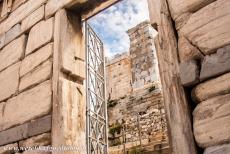
Acropolis of Athens: The Beulé Gate is located at the foot of the steep stone stairway leading up to the Acropolis. Visitors to the Acropolis pass through the Propylaea, the impressive entrance. The Beulé Gate served as a defensive gate. The gate was named after the French archaeologist Charles Ernest Beulé who uncovered the gate in 1852 beneath a bastion built by the Ottomans. The Beulé Gate was built in 267 AD.
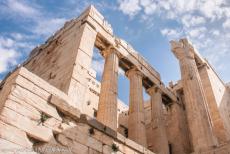
Acropolis, Athens: The Propylaea served as the main entrance to the Acropolis, it is situated just below the Temple of Nikè. The Propylaea was built from 437 to 432 BC. The columns represent the Doric as well as the Ionic style. The Doric front columns in the centre are about nine metres high, the Ionic columns at the entrance are about ten metres high. The Propylaea was probably connected to the worship of the gods who protected gates and doors.
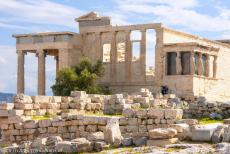
Acropolis, Athens: The Erechtheum viewed from the southwest, the Ionic temple was built in the period 421-407 BC, it was dedicated to the Greek goddess Athena and the Greek god Poseidon. The Erechtheum is famous for its columns, known as the Caryatids, female figures. It is said that the Erechtheum was built on the spot where the goddess Athena planted an olive tree and the god Poseidon hit the Acropolis with his trident to produce a salt water well.
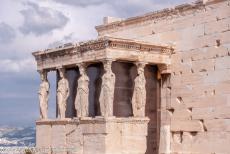
Acropolis, Athens: The Caryatids are the columns of the Erechtheion, the Caryatids are sculpted female figures serving as supports. The Caryatids were replaced by replicas in 1979. The original Caryatids were removed to the Acropolis Museum in Athens. The sixth Caryatid was removed by the English Lord Elgin and transported to the British Museum in London in 1805, with approval of the Ottoman Empire, that occupied Greece from 1453 until 1832. During the Ottoman rule, the Erechtheum functioned as a harem and and later as a gunpowder magazine.
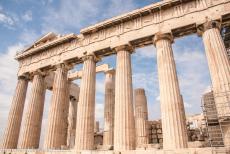
Acropolis of Athens: The west side of the Parthenon. The Parthenon is one the most famous buildings in the world, it was built in the period 447BC-437 BC. The Parthenon was dedicated to the Greek goddess Athena Parthenos, the protectress of the city of Athens. From 1802 to 1805, the English Lord Elgin removed half of the sculptures of the Parthenon with the permission of the Ottoman Empire and brought them to Britain. Now, the marble sculptures are known as the Elgin Marbles. Since 1817, the Elgin Marbles are on display in the British Museum in London.
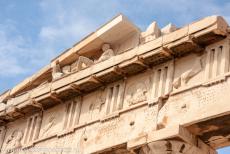
Acropolis of Athens: The frieze of the Parthenon. The Parthenon is a Doric Greek temple and the most important monument of the Acropolis of Athens. The enormous frieze of the Parthenon covers a length of about 160 metres and is about one metre tall. During the period of Ottoman rule in Greece, from 1453 until 1832, many of the sculptures of the Parthenon were sold to the British by the Ottomans. The sculptures are known as the Elgin Marbles.
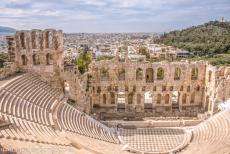
Acropolis of Athens: The Odeon of Herodes Atticus was built in the year 161, it was built during the Roman period by the Greek aristocrat and Roman senator Herodes Atticus in memory of his wife Regilla. The stone theatre is situated on the south slope of the Acropolis of Athens. The roof of the theatre was made of cedar wood from Lebanon. The Odeon of Herodes Atticus could seat about 6,000 spectators.
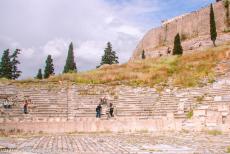
The Theatre of Dionysus is located on the south slope of the Acropolis of Athens, its remains are mostly from Roman times. The theatre already existed in the 6th century BC, but it was entirely rebuilt from 390 BC to 324 BC. The Ancient Greeks used it for their tragedies. During the Roman occupation of Greece, the theatre was also used for gladiator fights. The Theatre of Dionysus is the birthplace of modern theatre. It is the oldest stone theatre in the world.
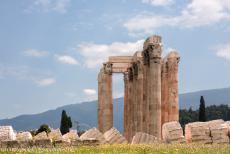
The Temple of Olympian Zeus, situated at the foot of the Acropolis of Athens, was dedicated to Zeus, the king of the Olympian gods. The Temple of Olympian Zeus was built in the 6th century BC. The unusual tall columns made the temple one of the largest ever built in the ancient world. The Corinthian columns are 17.5 metres high. The temple was built over several centuries and finally completed during the rule of the Roman Emperor Hadrian in 131 CE. Nowadays, fifteen columns are still standing, a sixteenth column lies on the ground.
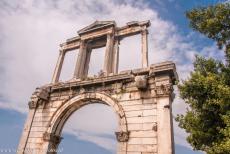
The Arch of Hadrian is situated at the foot of the Acropolis of Athens. The Arch of Hadrian is a monumental gateway, it spanned an ancient road in the centre of Athens. The marble arch was constructed without the use of mortar. It was built in 132 AD. The Arch of Hadrian is 18 metres high, 13.5 metres wide and 2.3 metres in dept. The imposing arch was erected in honour of the Roman Emperor Hadrian, a protector of the city of Athens.
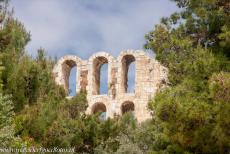
Acropolis of Athens: The Stoa of Eumenes is situated between the Theatre of Dionysus and the Odeon of Herodes Atticus along the Peripatos, the ancient road around the Acropolis of Athens. The Stoa of Eumenes was a Hellenistic colonnade, about 160 metres long and about 18 metres wide. The stoa was commissioned by King Eumenes II of Pergamon (197-159 BC). The stoa was destroyed in the 3th century, but a substantial part of the northern wall is still preserved, it was incorporated into the wall around the Acropolis.
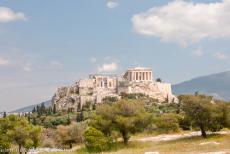
The Acropolis of Athens is the most famous acropolis in the world and it also belongs to the most important ancient monuments in the Western World. The Acropolis of Athens was first inhabited during the Neolithic Age and it was also inhabited during the Mycenaean period. The Acropolis of Athens is the symbol of the Ancient Greek civilization. The Acropolis of Athens was inscribed on the UNESCO World Heritage List in 1987.
